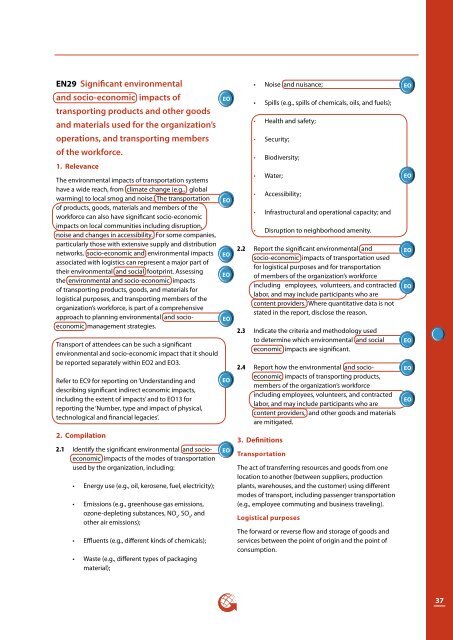Event Organizers Sector Supplement - Global Reporting Initiative
Event Organizers Sector Supplement - Global Reporting Initiative
Event Organizers Sector Supplement - Global Reporting Initiative
You also want an ePaper? Increase the reach of your titles
YUMPU automatically turns print PDFs into web optimized ePapers that Google loves.
EN29 Significant environmental<br />
and socio-economic impacts of<br />
transporting products and other goods<br />
and materials used for the organization’s<br />
operations, and transporting members<br />
of the workforce.<br />
1. Relevance<br />
The environmental impacts of transportation systems<br />
have a wide reach, from climate change (e.g., global<br />
warming) to local smog and noise. The transportation<br />
of products, goods, materials and members of the<br />
workforce can also have significant socio-economic<br />
impacts on local communities including disruption,<br />
noise and changes in accessibility. For some companies,<br />
particularly those with extensive supply and distribution<br />
networks, socio-economic and environmental impacts<br />
associated with logistics can represent a major part of<br />
their environmental and social footprint. Assessing<br />
the environmental and socio-economic impacts<br />
of transporting products, goods, and materials for<br />
logistical purposes, and transporting members of the<br />
organization’s workforce, is part of a comprehensive<br />
approach to planning environmental and socioeconomic<br />
management strategies.<br />
Transport of attendees can be such a significant<br />
environmental and socio-economic impact that it should<br />
be reported separately within EO2 and EO3.<br />
Refer to EC9 for reporting on ‘Understanding and<br />
describing significant indirect economic impacts,<br />
including the extent of impacts’ and to EO13 for<br />
reporting the ‘Number, type and impact of physical,<br />
technological and financial legacies’.<br />
EO<br />
EO<br />
EO<br />
EO<br />
EO<br />
EO<br />
• Noise and nuisance;<br />
• Spills (e.g., spills of chemicals, oils, and fuels);<br />
• Health and safety;<br />
• Security;<br />
• Biodiversity;<br />
• Water;<br />
• Accessibility;<br />
• Infrastructural and operational capacity; and<br />
• Disruption to neighborhood amenity.<br />
2.2 Report the significant environmental and<br />
socio-economic impacts of transportation used<br />
for logistical purposes and for transportation<br />
of members of the organization’s workforce<br />
including employees, volunteers, and contracted<br />
labor, and may include participants who are<br />
content providers. Where quantitative data is not<br />
stated in the report, disclose the reason.<br />
2.3 Indicate the criteria and methodology used<br />
to determine which environmental and social<br />
economic impacts are significant.<br />
2.4 Report how the environmental and socioeconomic<br />
impacts of transporting products,<br />
members of the organization’s workforce<br />
including employees, volunteers, and contracted<br />
labor, and may include participants who are<br />
content providers, and other goods and materials<br />
are mitigated.<br />
EO<br />
EO<br />
EO<br />
EO<br />
EO<br />
EO<br />
EO<br />
2. Compilation<br />
2.1 Identify the significant environmental and socioeconomic<br />
impacts of the modes of transportation<br />
used by the organization, including:<br />
• Energy use (e.g., oil, kerosene, fuel, electricity);<br />
• Emissions (e.g., greenhouse gas emissions,<br />
ozone-depleting substances, NO x<br />
, SO x<br />
, and<br />
other air emissions);<br />
• Effluents (e.g., different kinds of chemicals);<br />
• Waste (e.g., different types of packaging<br />
material);<br />
EO<br />
3. Definitions<br />
Transportation<br />
The act of transferring resources and goods from one<br />
location to another (between suppliers, production<br />
plants, warehouses, and the customer) using different<br />
modes of transport, including passenger transportation<br />
(e.g., employee commuting and business traveling).<br />
Logistical purposes<br />
The forward or reverse flow and storage of goods and<br />
services between the point of origin and the point of<br />
consumption.<br />
37

















